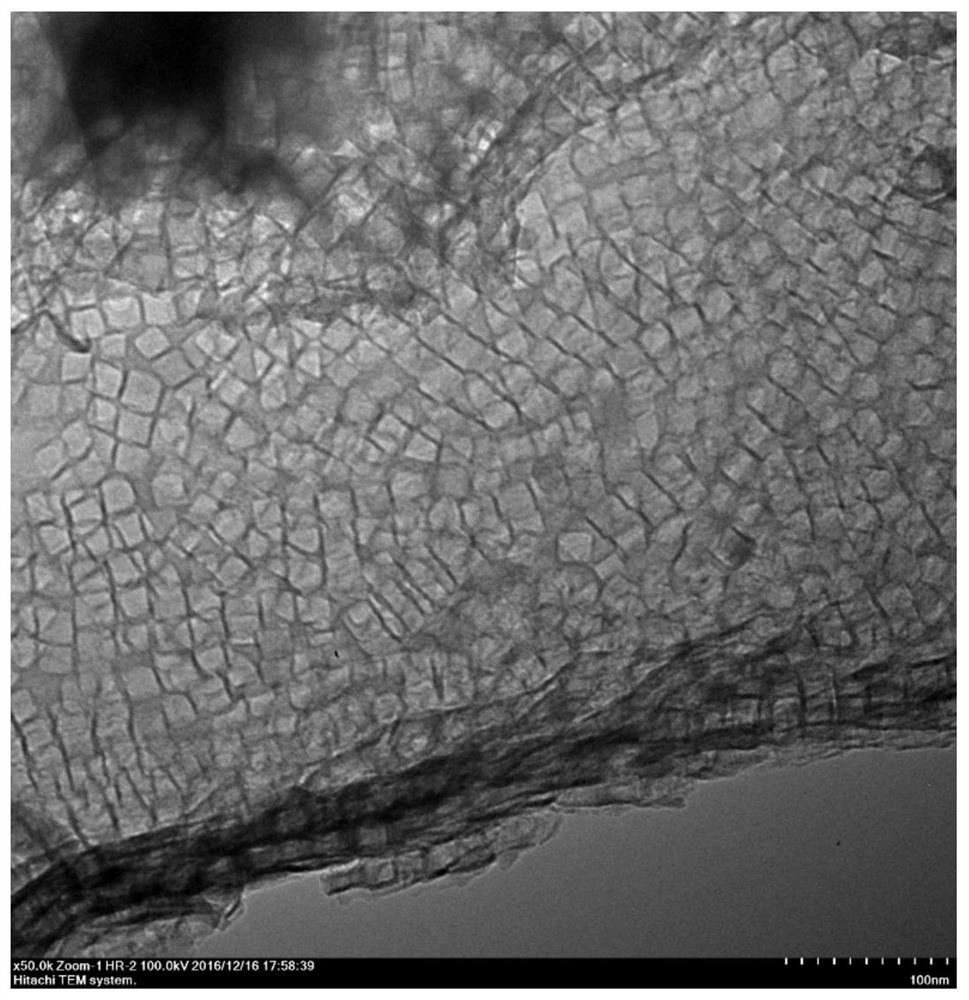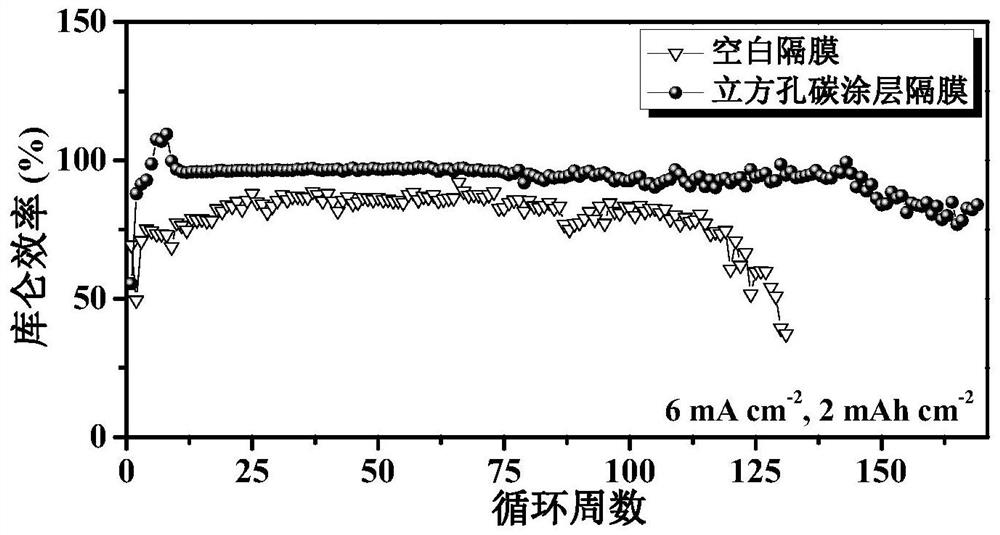A cubic hole carbon coating separator for lithium metal battery and preparation method thereof
A lithium metal battery and cubic technology, applied in the direction of lithium batteries, battery pack components, non-aqueous electrolyte batteries, etc., to achieve the effects of green and environmentally friendly large-scale production, improve lithium ion migration ability, and reduce interface impedance
- Summary
- Abstract
- Description
- Claims
- Application Information
AI Technical Summary
Problems solved by technology
Method used
Image
Examples
Embodiment 1
[0058] (1) Dissolve 1.1536g of ferric chloride and 0.4474g of manganese chloride in a small amount (5mL) of deionized water, add 20g of sodium oleate and mix well, heat to 80°C, keep warm for 3h and cool to room temperature to obtain template and precursor body mixture;
[0059] (2) Add powdered sodium sulfate 40g to the mixture obtained in step (1), and fully mix to obtain pre-carbonized material;
[0060] (3) Heating the pre-carbonized material to 700°C at a heating rate of 5°C / min in a nitrogen atmosphere, keeping it warm for 4 hours, and then cooling to obtain a cubic-pore carbon material with an inorganic salt template inside;
[0061] (4) Place the cubic-pore carbon material with the inorganic salt template in dilute hydrochloric acid for 6 hours to remove the template, and wash and dry (dry at 100° C. for 24 hours) to obtain a pure cubic-pore carbon material;
[0062] (5) Heating the cubic-pore carbon material to 800° C. at a heating rate of 5° C. / min in a nitrogen atm...
Embodiment 2
[0068] (1) Dissolve 1.1536g of ferric chloride and 0.4474g of manganese chloride in a small amount (5mL) of deionized water, add 10g of sodium oleate and mix well, heat to 80°C, keep warm for 3h and cool to room temperature to obtain template and precursor body mixture;
[0069] (2) Add powdered sodium sulfate 40g to the mixture obtained in step (1), and fully mix to obtain pre-carbonized material;
[0070] (3) Heating the pre-carbonized material to 500°C at a heating rate of 5°C / min in a nitrogen atmosphere, keeping it warm for 4 hours, and then cooling to obtain a cubic-pore carbon material with an inorganic salt template inside;
[0071] (4) Place the cubic-pore carbon material with the inorganic salt template in dilute hydrochloric acid for 6 hours to remove the template, and wash and dry (dry at 100° C. for 24 hours) to obtain a pure cubic-pore carbon material;
[0072] (5) Heating the cubic-pore carbon material to 800° C. at a heating rate of 5° C. / min in a nitrogen atm...
Embodiment 3
[0078] (1) Dissolve 1.1536g of ferric chloride and 0.4474g of manganese chloride in a small amount (5mL) of deionized water, add 7.2g of sodium gluconate and mix well, heat to 80°C, keep warm for 3h and cool to room temperature to obtain the template and a mixture of precursors;
[0079] (2) Add powdered sodium sulfate 80g to the mixture obtained in step (1), and fully mix to obtain pre-carbonized material;
[0080] (3) Heating the pre-carbonized material to 700°C at a heating rate of 5°C / min in a nitrogen atmosphere, keeping it warm for 4 hours, and then cooling to obtain a cubic-pore carbon material with an inorganic salt template inside;
[0081] (4) Place the cubic-pore carbon material with the inorganic salt template in dilute hydrochloric acid for 6 hours to remove the template, and wash and dry (dry at 100° C. for 24 hours) to obtain a pure cubic-pore carbon material;
[0082] (5) Heating the cubic-pore carbon material to 900°C at a heating rate of 5°C / min in a nitroge...
PUM
| Property | Measurement | Unit |
|---|---|---|
| current efficiency | aaaaa | aaaaa |
| current efficiency | aaaaa | aaaaa |
| current efficiency | aaaaa | aaaaa |
Abstract
Description
Claims
Application Information
 Login to View More
Login to View More - R&D
- Intellectual Property
- Life Sciences
- Materials
- Tech Scout
- Unparalleled Data Quality
- Higher Quality Content
- 60% Fewer Hallucinations
Browse by: Latest US Patents, China's latest patents, Technical Efficacy Thesaurus, Application Domain, Technology Topic, Popular Technical Reports.
© 2025 PatSnap. All rights reserved.Legal|Privacy policy|Modern Slavery Act Transparency Statement|Sitemap|About US| Contact US: help@patsnap.com



